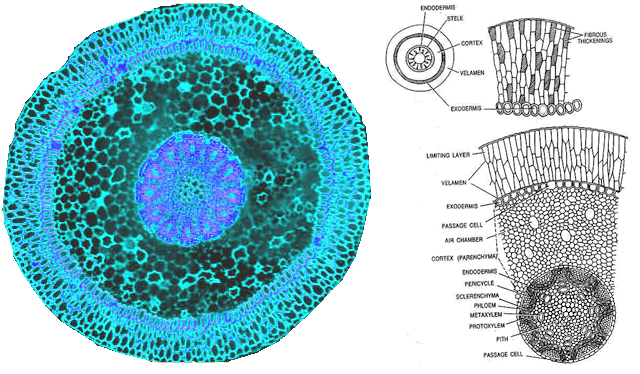No, I'm not talking about your family or genealogy (although that's a good precept to live by). Instead, I'm referring to our orchids' roots, and while many are familiar with the adage "good roots equals a good plant", we often give them little consideration beyond a couple of basics, so I thought it might be a good idea to look at roots a bit more closely.
The image to the left is the cross section of an orchid root, showing the outermost velamen, endodermis, cortex, and stele in the middle. Each of those layers has its own function, and may contain several, distinct structures, as can be seen on the right, with individual roles to play in the plant's survival. Rather than discussing what those detailed functions are, let's look at how those functions can be affected.
Orchid roots function to take up water and nutrients, preserve water loss, and also allows the exchange of gases to regulate life cycles. Root structures (i.e., cell shapes, sizes, types, and the number of cells from the cortex to the velamen) will vary from species to species and from plant to plant, depending on what and where it is growing. For this and many other reasons, orchids are highly adaptive to changing/varying environments.
Orchid roots develop differently depending on the environment within which they are growing. They can grow fully exposed dangling in the air, in partial contact with a surface (e.g., mounted on bark), and/or growing in a medium. When an aerial root touches a surface, the portion that makes contact with the surface will adapt differently so that the cellular function is optimized for the plant survival. For example, the area that contacts a piece of bark will often develop root hairs on the bottom side, together with smaller velamen cells and thin-walled passage cells. This will help an orchid cling to the bark and allow better transfer of water and air on the bottom side, where it is attached to the mount. On the exposed side, passage cells become more lignified or suberized (waxy) for protection and to slow water loss. Roots growing submerged in a medium can develop a modified velamen layer but do not always do so like roots exposed to to the air.
Let me reiterate: as roots grow, they "tailor" their cell structure to function optimally in that environment, and that once they have grown, they cannot change. That means that if you change the environment, whether that be repotting (even using the same medium), changing the cultural technique, or just moving it from a nursery greenhouse to your windowsill, the existing root system may no longer be optimal for the plant, so will weaken and die. That's why it is always best to repot a plant just as new roots are emerging from the growth front, as they will be optimal for that environment and support the plant as the old ones fail.
Established aerial roots placed into water (as compared to new roots that grow in water) usually survive and can adapt because aerial roots have outer cells that are structured to not allow water freely into- and out of the plant (but can still regulate gas exchange). This allows time (maybe a few months) for an orchid to adapt and grow "water roots" in the new water environment. Some aerial roots will rot soon after being placed into water but this can often be attributed to physical damage that occurred before being placed in water. A crack along any part of the root will allow water (and therefore fungi and/or bacteria) into the unprotected center of the root and rot occurs. Some aerial roots just cannot adapt to water conditions and die off, but hopefully new "water roots" have developed by that time.
As far as the functioning of roots that have rotted and only left a "string" in the middle - that section of the root contains the vascular tissues, used for transporting water, nutrients, fuel, hormones and chemical building blocks throughout the plant. They may function for a short while, but without the support and protection of the outer parts of the root structure, they will soon be lost.
The bottom line is this: whenever you change anything in your orchid culture - medium, growing style, watering frequency, pot size, or simply the plant's location - think about the potential impact on the roots, and make the needed secondary changes. For example, if you change to a coarser potting medium, you may need to raise the humidity and/or water more often. If you change to a technique that has moist, open, airy medium (semi-hydroponics being one), you may need to increase the humidity and temperature to compensate for the enhanced evaporative cooling. There are many ways that seemingly minor changes can affect the root zone of a plant, so give it some thought and try to anticipate what might happen and how to adjust for it.






























 Linear Mode
Linear Mode


